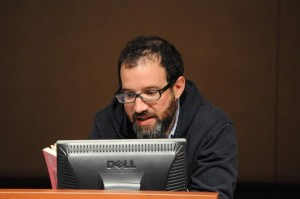Brazen novelist and short story writer Adam Levin read to the College from his newest collection of short stories, “Hot Pink,” on Wednesday, Nov. 20.
While ambitious in its operatic scope, Levin’s work is tangled up in its own cleverness, trying to sew up all the postmodern limbs it can find and animate a Frankenstein’s monster of storytelling to life.

Both Levin’s fictional work and his personal life revolve around the city of Chicago. The author received his M.A. in clinical social work from the University of Chicago, and later an M.F.A. in creative writing from Syracuse University.
Levin currently lives in Chicago, where he teaches creative writing at the School of the Art Institute of Chicago, and the impact on the arch of his stories is obvious. His 2010, 900-page novel, “The Instructions,” captured a youth rebellion within the Chicago public school system — “Hot Pink,” in turn, features settings and dialogue evocative of his home as well.
“I suppose I could write a story set in Syracuse, but I trust myself writing a story set in Chicago more,” Levin said in an interview with The Chicago Sun-Times. “I know the city, and I think I know the various ways people talk (there).”
Having a comfort zone in the Windy City has made for some breezy prose. Borrowing from the styles of Philip Roth and the late, coveted David Foster Wallace, Levin’s work is unabashedly a stream of consciousness, flowing freely from family dysfunction to flashy street violence. Sometimes it is engaging, and other times, its nonchalance is absurd.
“Hot Pink” erects ridiculous scenarios at breakneck speeds before shrugging them off as just another day in Chicago, such as the sudden brutality and sex of “Jane Tell.” Postmodernism can come with a warning label requesting a suspension of disbelief, but the story has to convince us it is worth our while to do so. In the case of “Jane Tell,” the particular story from which Levin read, the characters careened existentially around like a knockoff Chuck Palahniuk tale. It is marauding of “Fight Club” and is also subliminally obvious — shallow romance sparked at group therapy, emotional relief from physical violence and dialogue that quips but never sticks.
It is doubtful that Levin intended to copy-change “Fight Club” and ride off its success. But the action of stitching Palahniuk, Wallace, Salinger and even some Saunders into a new body of work comes with a caveat: If done carelessly, it’s bound to backfire.
It is worth noting that the first story in “Hot Pink” is called “Frankenwittcenstein.” Perhaps even Levin’s aware of the mismatched and uncoordinated creature he has engineered.
Levin has a tremendous gift for experimental ideas and a drive to write. A 900-page novel and 200 pages of frothing stories are not generated easily, after all. Nevertheless, Levin must be up to the challenge of better suturing his points together and finding a reliable editor.
“Writing’s hard — I think that when it’s not hard, it’s useless,” Levin said during his question and answer session.
For better or worse, those closing remarks had more inherent truth than his reading of “Hot Pink” could muster.






